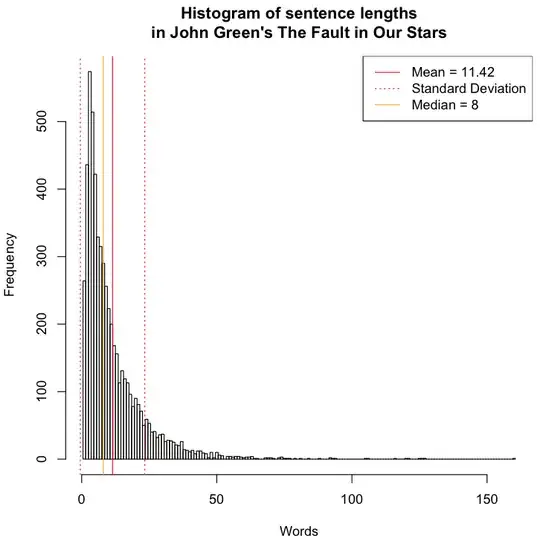Sentences should not be longer than 25 words, and ideal length is around 14 words.
The Inside GOV.UK blog cites research that finds that
when average sentence length is 14 words, readers understand more than 90% of what they’re reading. At 43 words, comprehension drops to less than 10%.
Studies also show that sentences of 11 words are considered easy to read, while those of 21 words are fairly difficult. At 25 words, sentences become difficult, and 29 words or longer, very difficult.
As a consequence, the GOV.UK style guide limits sentence length to 25 words.
The GOV.UK website needs to be accessible for everyone, so you might be tempted to think that when you write for a highly educated and intelligent audience you may allow yourself longer sentences, as @celtschk has recommended in their answer. But unless you publish academic research articles on your blog, that reasoning is wrong. As the cited blog post explains,
[l]ong sentences aren't just difficult for people who struggle with reading or have a cognitive disability like dyslexia or attention deficit hyperactivity disorder. They're also a problem for highly literate people with extensive vocabularies.
This is partly because people tend to scan, not read. In fact, most people only read around 25% of what’s on a page. This means it’s important to get information across quickly.
[...]
Long, complicated sentences force users to slow down and work harder to understand what they’re reading. This isn’t something people want to do, even if they’re familiar with the subject or language you’re using.
It’s easy to assume this isn’t the case for highly literate readers or people considered experts. Yet the more educated a person is, and the more specialist their knowledge, the more they want it in plain English.
These people often have the least time and most to read. Which means they just want to understand your point and move on, quickly.
So, whoever your audience is, if you want your blog posts to be read, stick to the upper limit of 25 words and make most of your sentences around 14 words long.
In case you think that these lengths only apply online and that printed fiction generally has longer sentences, here are some average sentence lengths for you to consider:
- Victor Hugo, Les Miserables: 15.56 words per sentence
- Mark Twain, Adventures of Huckleberry Finn: 18.38
- Jane Austen, Pride and Prejudice: 20.54
- Arthur Conan Doyle, Adventures of Sherlock Holmes: 15.48
- Lewis Carroll, Alice’s Adventures in Wonderland: 17.71
- Charles Dickens, A Tale of Two Cities: 17.66
- James Joyce, Ulysses: 7.23
- Herman Melville, Moby Dick: 21.32
- Bram Stoker, Dracula: 16.52
- Jane Austen, Sense & Sensibility: 23.15
- Charles Dickens, A Tale of Two Cities: 17.711
- Mark Twain, The Adventures of Tom Sawyer: 14.568
- J.R.R. Tolkien, The Hobbit: 16.342
- C.S. Lewis, The Lion, The Witch, and The Wardrobe: 15.175
- J.K. Rowling, Harry Potter and The Sorcerer's Stone: 11.767
- Stephenie Meyer, Twilight: 9.629
And while John Green's The Fault in Our Stars begins with the 52 word sentence cited by @DPT in their comment, it has an average sentence length of only 11.12091 words!
The above are recommendations for English. So how about other languages? For German, the Deutsche Presse Agentur, the largest press agency in Germany, sets the upper limit for optimal comprehension at 9 words and the absolute allowed maximum length at 30 words. The Bild Zeitung, Germany's largest tabloid newspaper, has an average sentence length of 12 words. Ludwig Reiners in his book on style sets the maximum length of easy to understand sentences at 18 words; Wilfried Seibicke, a linguist and specialist in stylistics, recommends an average of 10 to 15 words.
Given the similarity between the recommendations for English (an analytic language) and German (a fusional language), I would assume that other indoeuropean languages have similar ideal word lengths, while agglutinative (e.g. Turkic or Finnish) and polysynthetic languages, where sentences consist of very few very long words, will have other ideal lengths.
This answer, by the way, has an average sentence length of 20.8125 words (not counting the citations).
As requested, some statistics for John Green's The Fault in Our Stars (all values are sentence lengths in words):
N = 5763, M = 11.42, SD = 11.93, Mdn = 8, range = 1-160
That is, the average sentence is 11 words long; half of all sentences are 8 words long or shorter; 88% or 5089 of all sentences are between 1 and 23 words long. The modus (most frequent sentence length) lies at 3 words with 574 sentences. Here is a histogram illustrating the distribution:

